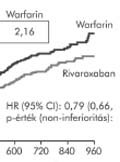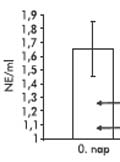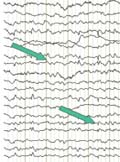The eLitMed.hu medical portal uses computer cookies for convenient operation. Detailed information can be found in the Cookie-policy.
Clinical Neuroscience - 2012;65(11-12)
Content
[Rivaroxaban in prevention of stroke in patients with atrial fibrillation]
[Atrial fibrillation (AF) is well established risk factor for cardioembolic stroke. With thromboprophylatic treatment we can reduce the risk of stroke in patients with AF. Oral vitamin K antagonists (VKA) such as warfarin and acenocoumarol are effective for stroke prevention in patients with atrial fibrillation. VKAs are associated with several limitations including very narrow therapeutic range, several factors (diet, drugs, alcohol consumption) affecting the effect of VKA and excessive bleeding may occur if INR value not controlled successfully. New oral anticoagulant direct Xa factor inhibitor rivaroxaban has a good therapeutic efficacy in prevention (primary and secondary) of stroke in AF patients. Its advantages are including no need for monitoring, fixed oral dose, not affected by meal, age and body weight, all of them can improve patient adherence. In ROCKET AF trial in patients with AF, rivaroxaban was noninferior to warfarin for the prevention of stroke or systemic embolism. There was no significant between-group difference in the risk of major bleeding, although intracranial and fatal bleeding occurred less frequently in the rivaroxaban group.]
[Clinical significance of the cardiovascular effects of fingolimod treatment in multiple sclerosis]
[Fingolimod is a sphingosine-1 phosphate receptor modulator, which is effective in the treatment of severe relapsingremitting form of multiple sclerosis. Once daily oral use of fingolimod decreased the annualized relapse rate, inflammatory brain lesion activity and the rate of brain atrophy compared both to placebo and intramuscular administered interferon beta-1a. The drug targets the cardiovascular system as well via sphingosine- 1 phosphate receptors. After initiation of fingolimod therapy transient sinus bradycardia and slowing of the atrioventricular conduction develops. The onset of the effect is as early as 1 hour post administration, while heart rate and conduction normalized in 24 hours in most of the cases. According to the clinical trials symptomatic bradycardia developed in 0.5% of the cases, responding to the appropriate therapy. The incidence of Mobitz I type II atrioventricular blocks and blocks with 2:1 atrioventricular conduction was 0.2% and 0.1%, respectively. All of these cardiovascular events showed regression during observation and no higher degree atrioventricular blocks were detected at the approved therapeutic dose. Following the first dose effect, fingolimod had a moderate hypertensive effect on long-term. For the safety of fingolimod treatment detailed cardiovascular risk stratification of all patients, adequate patient monitoring after the first dose and competency in treating the possible side effects is necessary. In patients with increased cardiovascular risks, treatment should be considered only if anticipated benefits outweigh potential risks and extended monitoring is required.]
[Aspirin and clopidogrel resistance: possible mechanisms and clinical relevance. Part I: Concept of resistance]
[Aspirin and clopidogrel are well established as antiplatelet medication in the treatment of atherothrombotic vascular disease. However, despite treatment, a substantial number of patients experience recurrent ischemic episodes, referred to as aspirin or clopidogrel treatment failure. Various laboratory techniques are available with which to evaluate the effectiveness of antiplatelet drugs. Interestingly, the agreement between the results of the different tests may be poor. The term aspirin or clopidogrel resistance denotes those conditions in which an inadequate inhibitory efficacy of the given antiplatelet agent is detected by an in vitro assay of platelet function. It has been estimated that on average some 30% of patients treated with aspirin, and 20% on clopidogrel, do not achieve an appropriate level of efficacy as concerns platelet activity.]
[Vinpocetin in neurological diseases]
[Introduction - Stroke is the third leading cause of death worldwide (following cardiovascular and cancer mortality) and associated with serious disability for the vast majority of patients. There is no salvage therapy for irreversibly damaged brain areas, improving the circulation of the surrounding hypoperfused territories may be associated with benefitial clinical states. Cerebral hypoperfusion may play a role in the pathogenesis of other kind of neurological diseases, improvement of global circulation may have a preventive effect on these conditions. Aims - The aim of our study was to review the experimental and clinical articles focusing on the role of vinpocetin in different neurological conditions. Results - Vinpocetin appears to have several different mechanisms of action that allow for its antiinflammatory, antioxidant, vasodilating, antiepileptic and neuroprotective activities in experimental conditions. On the other hand, several meta-analysis of the existing studies in acute stroke examining short and long term fatality rates with vinpocetin was unable to assess efficacy. In chronic cerebrovascular patients, vinpocetin improves impaired hemorheological variables, has significant vasodilating properties, improves endothelial dysfunction, neuroimaging studies showed selective increase in cerebral blood flow and cerebral metabolic rate, all of which are potentially beneficial in cerebrovascular disease and may improve cognitive functions. Summary - Based on the above mentioned results vinpocetin plays an important role both in basic research and in clinical management of different neurological diseases.]
[The role of immobilization stress and sertindole on the expression of APP, MAPK-1 and β-actin genes in rat brain]
[Stress, depending on its level and quality, may cause adaptive and maladaptive alterations in brain functioning. As one of its multiple effects, elevated blood cortisol levels decrease the synthesis of the neuroprotective BDNF, thus leading to hippocampal atrophy and synapse loss, and rendering it a possible cause for the Alzheimer’s disease (AD) related neuropathological and cognitive changes. As a result of the stress response, intraneuronal alterations - also affecting the metabolism of β-actin - can develop. These have a role in the regulation of memory formation (LTP), but in pathological conditions (AD) they could lead to the accumulation of Hirano bodies (actin-cofilin rods). According to the dementia treatment guidelines, the behavioural and psychological symptoms of AD can be treated with certain antipsychotics. Therefore, the aim of our study was to examine the effects of sertindole (currently not used in the standard management of AD) on the transcription of some AD associated genes (amyloid precursor protein [APP], mitogen activated protein kinase-1 [MAPK-1], β-actin) in the brain of rats exposed to chronic immobilization stress (CIS). Male Wistar rats were exposed to CIS for three weeks. The four groups were: control (n=16), CIS (n=10), 10 mg/kg sertindole (n=5) and 10 mg/kg sertindole + CIS (n=4). Following transcardial perfusion, the relative levels of hippocampal and cortical mRNA of the previously mentioned genes were measured with real-time PCR. CIS induced hippocampal β-actin (p<0.01), MAPK-1 and APP (p<0.05) mRNA overexpression. The simultaneous administration of sertindole suppressed this increase in β-actin, MAPK-1 and APP expression (p<0.05). Ours is the first report about CIS induced β-actin gene overexpression. This finding, in accordance with the similar results in APP and MAPK-1 expression, underlines the significance of cytoskeletal alterations in AD pathogenesis. The gene expression reducing effect of sertindole suggests that antipsychotic drugs may have a neuroprotective effect.]
[Clinical experiences with Creutzfeldt-Jakob disease: three case studies]
[The clinical picture, electroencephalographic, imaging and cerebrospinal fluid parameters as well as the molecular background of Creutzfeldt-Jakob disease have been well explored. The diagnostic criteria, offering clinicians a fair chance to identify these patients in vivo, have recently been updated. However, the diagnosis is still a challenge in everyday neurological routine. We report on three of our Creutzfeldt-Jakob patients for calling attention to the classical and the recently defined features of the disease. We conclude that based on the rapidly progressing neuropsychiatric syndrome Creutzfeldt-Jakob disease may be suspected; follow-up EEG may reveal the typical (pseudo)-periodic pattern with progressive deterioration of the background activity. In addition, diffusion-weighted brain MRI imaging (DWI) has high diagnostic value. Detection of 14-3-3 protein in the cerebrospinal fluid supports the in vivo diagnosis.]
[Account on the scientific meeting of Környey Society in 2012]
[Account on the scientific meeting of Környey Society in 2012 2012;65(11-12)]
1.
Clinical Neuroscience
[Headache registry in Szeged: Experiences regarding to migraine patients]2.
Clinical Neuroscience
[The new target population of stroke awareness campaign: Kindergarten students ]3.
Clinical Neuroscience
Is there any difference in mortality rates of atrial fibrillation detected before or after ischemic stroke?4.
Clinical Neuroscience
Factors influencing the level of stigma in Parkinson’s disease in western Turkey5.
Clinical Neuroscience
[The effects of demographic and clinical factors on the severity of poststroke aphasia]1.
2.
3.
4.
5.
















